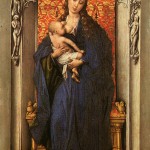 Tomberg remarks in his Meditations that Christianity places the locus of sin, not in the body or material existence (such as he thinks is implied to a degree by Eastern metaphysic), but in the soul. The body, then, as such, becomes rather a focus of redemption and revelation, rather than something which needs to be shed (along with the sense of “self”), in order to attain Enlightenment. Tomberg even refers to the personality as the “lost sheep” or lonely and vulnerable flock which the Lord came intending to seek and to save. These views can be linked with his comments on hermeticism differing even from “saintliness”, in which he insists that the hermetic is like Jacob wrestling with the angel, in that it refuses to sacrifice or suborn its intellect. Instead, it wishes the intellect to be “re-made” but kept, in the image of holiness. This defines Tomberg’s path over and against those of magical bent (such as Franz Bardon) who might seem to believe that no essential connection exists between purification/illumination/theosis and the awakening of the vital bodies, and those who utterly reject Tomberg’s aspiration to pursue something which is essentially different than the saintly path of (say) someone like Saint Cuthbert, who waded into icy sea water and sang psalms all night long to develop their will. Tomberg (I think) would say that the saints truncated a part of their personality, and that the magicians sacrificed a piece of their soul.
Tomberg remarks in his Meditations that Christianity places the locus of sin, not in the body or material existence (such as he thinks is implied to a degree by Eastern metaphysic), but in the soul. The body, then, as such, becomes rather a focus of redemption and revelation, rather than something which needs to be shed (along with the sense of “self”), in order to attain Enlightenment. Tomberg even refers to the personality as the “lost sheep” or lonely and vulnerable flock which the Lord came intending to seek and to save. These views can be linked with his comments on hermeticism differing even from “saintliness”, in which he insists that the hermetic is like Jacob wrestling with the angel, in that it refuses to sacrifice or suborn its intellect. Instead, it wishes the intellect to be “re-made” but kept, in the image of holiness. This defines Tomberg’s path over and against those of magical bent (such as Franz Bardon) who might seem to believe that no essential connection exists between purification/illumination/theosis and the awakening of the vital bodies, and those who utterly reject Tomberg’s aspiration to pursue something which is essentially different than the saintly path of (say) someone like Saint Cuthbert, who waded into icy sea water and sang psalms all night long to develop their will. Tomberg (I think) would say that the saints truncated a part of their personality, and that the magicians sacrificed a piece of their soul.
Rather than looking at this as a Hegelian synthesis, perhaps we should see Tomberg as essentially re-uniting something which was once indivisible, on a higher plane. I will call this the path of the “hermit”, using Tomberg’s own image. This (I would argue) should be seen as the path of the Middle Ages, which abrogated the reign of the saints (from St. Martin all the way to St. Guthlac) in seeking a more “human” path, somewhere in between “beast” and “god”. For instance, Saint Martin might have helped save the Empire by engaging in martial leadership, but chose instead to pursue the “saintly path” of abnegation. Anyone who has read Evola would have to feel a twinge of regret when reading the life of the this saint.
How is this path to be sought? I will not necessarily argue that it has to take place within the “Church” (the body of Christ) – for a number of reasons, this is impracticable. Tomberg gives us another clue in Meditations – those who are “humble” have certainly been in the presence of God. But what, he asks, if they have not consciously known this? What then? Is the intuition invalid? No, they have experienced it somewhere else, either in a dream, or somewhere even more dreamlike.
And this leads us back to “deep materiality”. In the “Secret Life of Doctor Honigberger”, Eliade suggests that the Divine Absolute keeps most of us from developing our spiritual powers in order to both protect us, and prepare us, for that world. A certain detachment, and asceticism is necessary, because to suddenly enter it would be a sensory overload which would lead to destruction at worst, confusion and loss at best. The Middle Ages embodied the most “natural” and “sane” path because it balanced an awareness of this life as an “antechamber”, while giving full play to the grace inherent in the innocent body. It was the soul which needed (above all) purification, not the body, or the spirit. This was the secret genius and angel which united Europe and created Christendom. As the picture reminds us, the blessed Theotokos actually nursed the man-God, who did not scorn to become a child. Let us, then, not scorn the “days of small things” when we are as children, and are not as we shall become. Not yet.

Leave a Reply